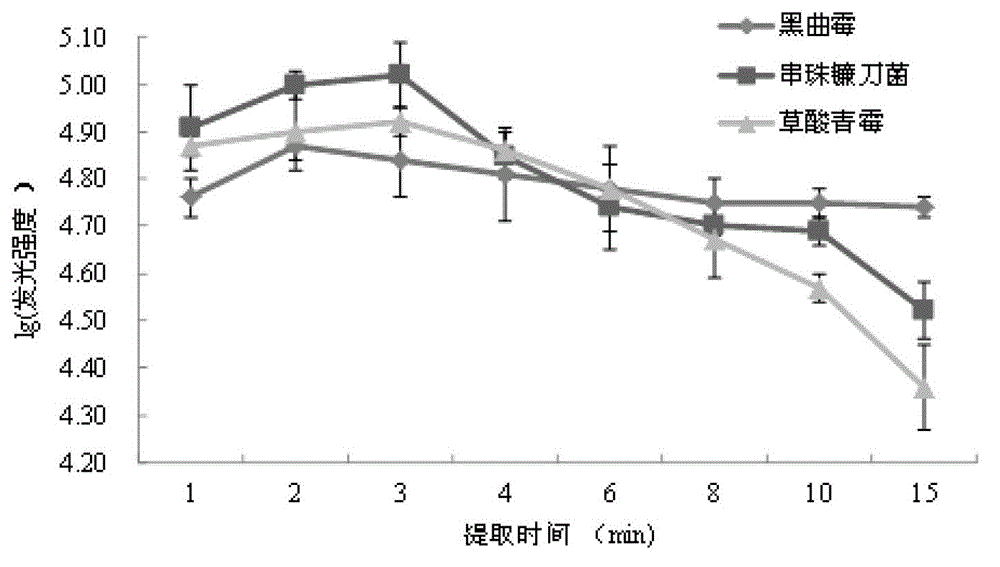Metering method for rapid measurement of mould in stored grain through ATP bioluminescence method and applications
A bioluminescence, measurement method technology, applied in the direction of chemiluminescence/bioluminescence, analysis by chemical reaction of materials, etc., can solve the problem of grain storage mold without ATP bioluminescence method, so as to ensure food safety and high sensitivity , the effect of simple operation
- Summary
- Abstract
- Description
- Claims
- Application Information
AI Technical Summary
Problems solved by technology
Method used
Image
Examples
Embodiment 1
[0041] Embodiment 1 different ATP releasing agent releases the method and effect of ATP to mold
[0042] The methods for releasing ATP from molds by different ATP release agents and their corresponding effects will be described below.
[0043] Take 25g of corn, add it to an Erlenmeyer flask filled with 225mL of sterile water and 10 glass beads, oscillate on a shaker for 30 minutes at a speed of 140 rpm, and obtain a bacterial suspension for later use.
[0044] 1. BAC extraction method
[0045] Take 100mL of bacterial suspension for suction filtration, the filter membrane used for suction filtration is a filter membrane with a pore size of 0.22um, then transfer the filter membrane to a test tube containing 10mL of 0.15% BAC solution, and place it in a water bath at 30°C at 140 rpm. Min shaking and extracting for 3 min, the reaction solution was obtained, which was stored at 4°C until testing. 2. TCA method
[0046] Take 100mL of bacterial suspension for suction filtration, t...
Embodiment 2B
[0071] In summary, the use of surfactant BAC has the best effect on mold release of ATP. Embodiment 2 BAC is to the optimal condition of the influence of luciferin-luciferase reaction system and mold ATP extraction
[0072] 1. The effect of BAC on the luciferin-luciferase reaction system
[0073] Standard ATP (10 -7 mol / L) were diluted to 10 -8 、10 -9 、10 -10 、10 -11 mol / L ATP working solution. Prepare two reagents: Reagent A (75 μL sterile water,
[0074] as a control); Reagent B (25 μL 0.1% BAC+50 μL sterile water). 25 respectively μ Add 1 L of ATP working solution of different concentrations to 75 μL of the two reagents, take 100 μL of the mixed solution, add to 100 x In the LrL / L reagent, the luminescence value was measured after mixing, and the results are shown in Table 2.
[0075] The effect of table 20.1% BAC reagent on mold ATP bioluminescent reaction
[0076]
[0077] It can be seen from Table 2 that compared with the control group, the luminescence val...
Embodiment 3
[0088] Example 3 Correlation analysis between ATP luminescence method and traditional plate counting method and application in corn storage experiment
[0089] 1. ATP luminescence method to measure the number of molds
[0090] (1) Take 25g of corn, add it into a Erlenmeyer flask filled with 225mL of sterile water and 10 glass beads, shake it on a shaker for 30min at a speed of 140rpm, and obtain a bacterial suspension for later use.
[0091] (2) Take 100mL of bacterial suspension for suction filtration. The filter membrane used for suction filtration is a filter membrane with a pore size of 0.22um. Rotate / min shake and extract for 3 minutes to obtain the reaction solution, which is to be tested;
[0092] (3) Add 100 μL of the reaction solution in step (2) to 100 μL rL / L reagent, use the bioluminescence module of the multi-functional microplate reader TECANINFINITE200, set the measurement temperature to 30°C, and measure the luminescence value.
[0093] 2. Correlation analysi...
PUM
 Login to View More
Login to View More Abstract
Description
Claims
Application Information
 Login to View More
Login to View More - R&D
- Intellectual Property
- Life Sciences
- Materials
- Tech Scout
- Unparalleled Data Quality
- Higher Quality Content
- 60% Fewer Hallucinations
Browse by: Latest US Patents, China's latest patents, Technical Efficacy Thesaurus, Application Domain, Technology Topic, Popular Technical Reports.
© 2025 PatSnap. All rights reserved.Legal|Privacy policy|Modern Slavery Act Transparency Statement|Sitemap|About US| Contact US: help@patsnap.com



